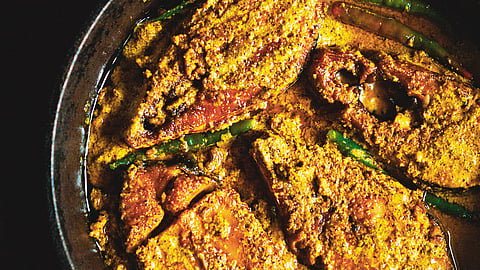
- Destinations
- Experiences
- Stay
- What's new
- Celebrating People
- Responsible Tourism
- CampaignsCampaigns
- SubscribeSubscribe
- Buy Now

“Tor jonne ilish maacch enechi," (I have bought hilsa for you), my grandfather calls out after returning from his Sunday morning haul, and I know monsoon has arrived.
Bengalis take to the inconveniences brought on by the rain like champions only because, on any given day, their grandmothers would rustle up their favourite preparation of the fish, and it will all be worth it. And for Bengali men, who, armed with a baajar er tholi, set out to secure the best cut and size at the best price, the hilsa season is a chance to prove their merit at the art of buying fish.
You see, it is not just about any fish available around this season. The hilsa, bestowed the title “Queen of Fishes,” rules over a kingdom extending beyond West Bengal and Bangladesh. She’s quite the globetrotter too, or as they call it in the piscine world, anadromous. Born in the fresh water, the hilsa sails away to the sea and then returns to the same river to spawn, propelled by the southwest monsoon currents.
From the Bay of Bengal, the hilsa swims a distance of 50 to 100 km against the tide to find her way back to where she came to be. It could either be the Bhagirathi-Hooghly, Rupnagar (known for Kolaghat hilsa), lower Brahmaputra, Narmada or Godavari in India, Padma and Meghna in Bangladesh, Irrawaddy in Myanmar, and Indus in Pakistan.
Ecological issues have cut the hilsa’s route short and its life span too. In West Bengal and Bangladesh, where tens of thousands of local fishermen traditionally depend on the season’s catch to improve their financial realities, disturbed conditions caused by exploitative practices wash over their chances of doing so.
The crisis has arranged itself into tug of war, without a winner. In addition to climate change and pollution, the year-round demand for the fish has set the stage for practices that inflict long-term damage and interrupt their ecosystem.
According to a study published in "The Proceedings of the National Academy of Sciences, India, Section B: Biological Sciences," titled "Present Status of the Sustainable Fishing Limits for Hilsa Shad in northern Bay of Bengal, India,” the number of boats that sailed out in search of hilsa increased by 25 per cent from 2002 to 2015, while the catch reduced by 13 per cent. Among them, trawlers featuring nets with mesh holes less than 90 mm to catch juvenile fishes leave local fishing communities lagging behind. Their movement also destroys the fish’s food—zooplanktons and phytoplanktons—compelling them to take a detour.
Nowadays, a trip to the maachher baajar, at any time of the year will not be complete without sightings of the hilsa. But this wasn’t always the case. Earlier, it was an occasion, or a mission even, depending on how seriously you took it.
“Growing up, eating ilish was something that we looked forward to—it was special. Its presence in a meal meant that it had been planned in advance,” reminisces Avinandan Kundu, head chef at Sienna Cafe in Kolkata. He adds, “We used to buy the ilish and used it bit by bit, storing what was left of it for later. Inherently, there was always a sustainable way of eating ilish across households.”
But now, the craving for ilish maachher tel jhol can strike the innocent even in the odd month of April and have it be satiated.
“If you go to any baajar right now, you could never imagine that there is a crisis,” says Kundu. Despite the bans set by the government on fishing during the breeding months of April and October, trawlers venture out to the sea in their search. Juvenile hilsas are baited for, hampering their growth and resulting in soaring prices—touching approximately Rs 3,000 per kilo.
“In my household, as a rule, we don’t buy fish weighing below a kilo. However, this sustainable practice of buying hilsa at its full maturity is tinted by the complexities of class. What about those who can’t afford to buy it for three grand?” Kundu pauses and then continues, “For those who can make this choice, it is important that they do so. We need to put in more effort to be aware. Visiting the local market, engaging with the vendors, learning about seasonality and the market patterns is a great starting point.”
To give hungry customers what they want, restaurants have leveraged and, as a result, fostered its year-round availability. In October, when hilsa’s peak breeding season collides with the region’s biggest festival, Durga Puja, the situation worsens as demand surges. “Restaurants also need to be at the forefront of encouraging better buying practices,” says Kundu.
Talking about how Sienna does it, Kundu takes recourse to the past, “Historically, we have taken every part of the fish, from head to tail, and developed recipes around it." These recipes served as a muse to Kundu when conceptualising the “muro to lyaja” or “head to tail” spread for Sienna last year. The spread featured ilish bhaaja, lyaaja diye bharta, muro diye tok, and tel diye chinekamini gola bhaat—not a single part was spared as waste.
Lending itself perfectly to prose as it does to mustard gravy, Buddhadeva Bose’s poem “Ilish,” published in 1943, best captures the fisherfolk’s plight:
...The nets fall with vigour,
The ropes are drawn,
Those who are half-naked,
They are without food,
The wealth of food...
